OPINIONS





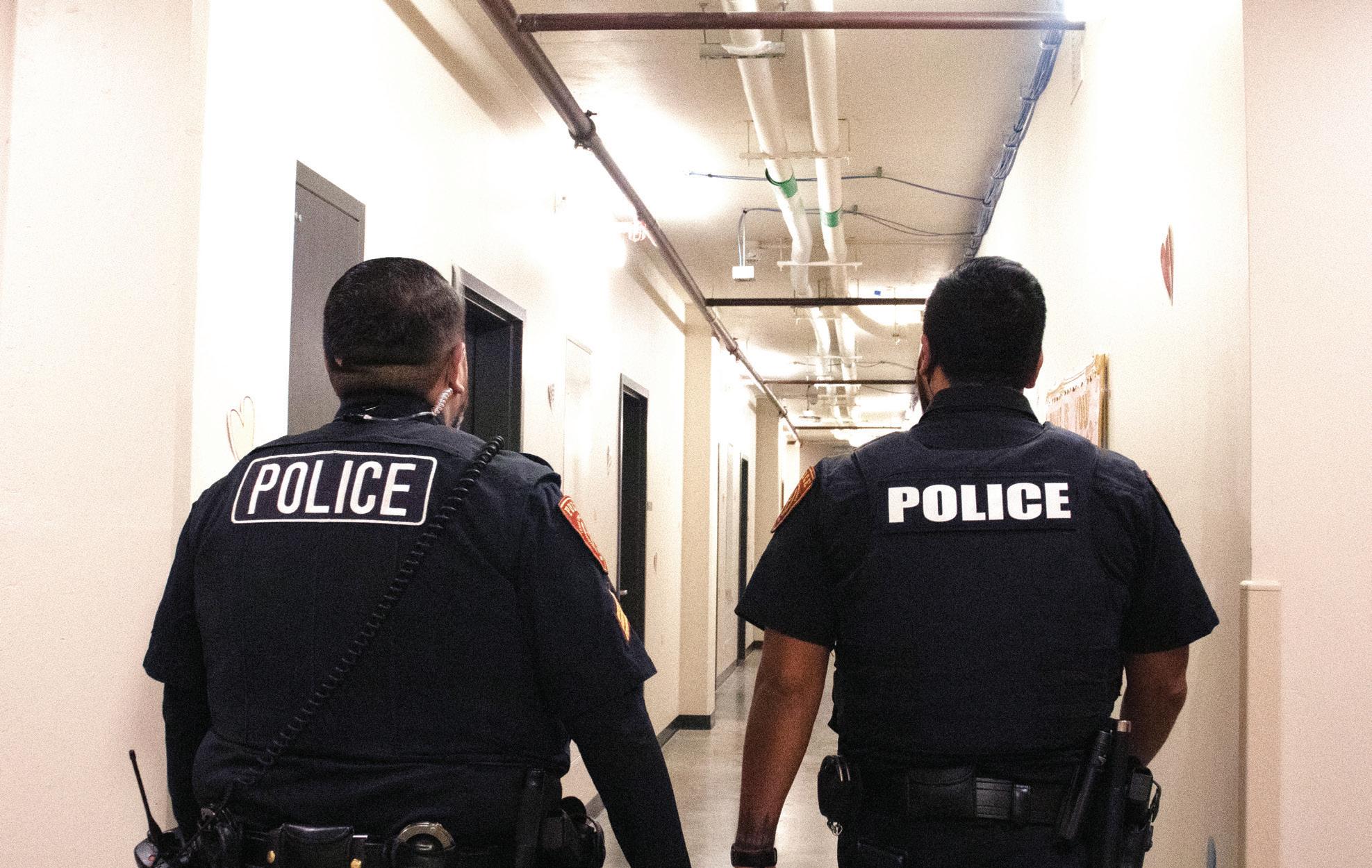
meeting, where they identified the Department of Housing and Residential Life (DHRL) as a priority for the spring semester.
University Police Department (UPD) officers are patrolling dorms more frequently this semester in an effort to enhance security in on-campus housing.
According to UPD Chief Matthew Carmichael, officers conducted 595 patrol checks across all 26 dorms in January, a significant increase from 215 in January 2024. Since the beginning of the semester, at least one officer has been stationed at each dorm “all the time,” something Carmichael hopes to continue going forward.
Carmichael said UPD leadership decided to increase patrols following a December
“We thought ‘What is one of the best ways we can improve our service to our students who live here?’ We came up with increased patrols and doing some crime prevention interaction and training, starting with the [resident assistants] RAs,” Carmichael said.
Record enrollment was another factor behind the increased patrols, which brought more than 9,000 freshmen who live on campus, according to Carmichael.
By
session began on Jan. 14 and ends June 2.
Public colleges and universities may be required to begin carrying Narcan in residence halls with a new bill from Texas’ 89th legislative session.
State Sen. Nathan Johnson introduced Senate Bill 556 (SB 556), which would require Texas public universities to keep opioid antagonists, such as Narcan, in residence halls and train resident advisors on how to identify opioid overdoses and administer Narcan.
“The supply of opioid antagonists at a campus must be stored in a secure location at each residence hall and be easily acces sible to resident advi sors authorized and trained to administer an opioid antagonist,” SB 556 text stated.

By Marisa Nuñez Editor In Chief
The co-owners of Grins are preparing to say goodbye to their workplace of 50 years after selling the restaurant to a San Marcos local following the 50-year anniversary of the restaurant.
After opening on Valentine’s Day 1975, Paul Sutphen began his first shift at Grins as its first cook on March 1, 1975.
Sutphen, co-owner of Grins, was a senior at Texas State when he began working at Grins as a way to get by.
“I got $2 an hour,” Sutphen said. “It was just survival, just a way to get through school.”
Johnny Ferrell, co-owner of Grins, started working at Grins in the summer of 1975 and like Sutphen, was looking for a way to pay for rent and school.
Sutphen bought out one of the partners in 1977, followed by Ferrell in 1979. After 50 years of working together at Grins, Sutphen and Ferrell are selling their beloved restaurant.
“We’re selling out after 50 years, we’re going to walk away from this place,” Sutphen said. “We’ve got another local… with his group [who] are going to take over the restaurant within the next few weeks and we’re so happy for that because it’s local. He wants to keep Grins, Grins… and that’s a big pride thing.”
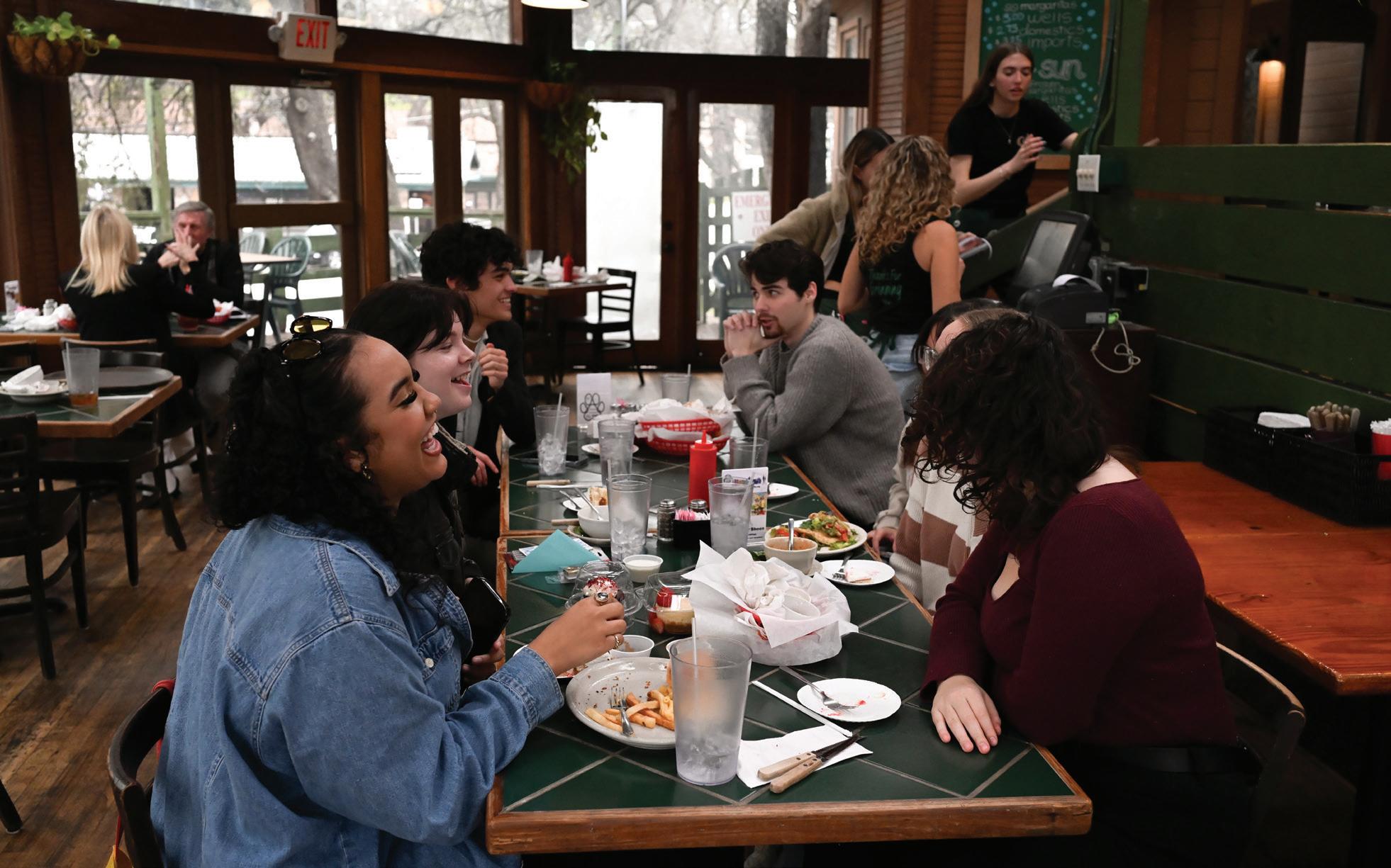

Tuesday, February 18, 2025
By James Phillips News Reporter
San Marcos earned the official designation of Bird City for its efforts in bird conservation.
The designation, announced by the Texas Parks and Wildlife Department (TPWD) on Jan. 16, means San Marcos joined cities like Austin and San Antonio in committing to avian conservation, according to Nikki Lake, Discovery Center specialist for San Marcos.
According to TPWD’s press release, San Marcos was recognized for its dedication to protecting the city’s green spaces.
“[San Marcos is] recognized for its conservation of riparian habitats, avian expertise in the area, expansive partnerships to protect green spaces in this ever-growing community,” TPWD wrote.
Lake said that although the designation doesn’t come with additional funding, it prompted the city to organize conservation events for residents. Details on these events will be announced at the Migratory Bird Day Festival on May 11.
Clay Green, professor of conservation biology, said San Marcos is especially important for migratory bird species, such as the goldencheeked warbler, due to its location along the Central Flyway, a major migration route that birds follow when traveling between their breeding and wintering grounds.
“[San Marcos] may not provide the habitat for [the migratory birds] to breed, but it provides them the habitat to forage... and that’s what we call a migratory stopover habitat,” Green said.
Lake said during migration seasons, which happen from March to May and September to November each year, millions of birds can fly over San Marcos in one night.
“[San Marcos is] a really great stopover site for migrating birds,” Lake said. “During migration, we have millions [of birds flying over San Marcos]; last year we had a night where we had a billion birds flying over.”
According to Lake, a key aspect of the city’s conservation efforts for migratory birds is preserving over 1,500 acres of undeveloped land in San Marcos parks, called natural areas, which provide essential habitat and resting spots.
She said another important aspect of San Marcos’ success in conservation is its collaboration with partner organizations, such as the Meadows Center and the Greenbelt Alliance.
“[The city] gets together with... everybody to find out what they were doing to protect birds, besides just what [[the city is] are doing, and that really helped a lot,” Lake said.

Lake said the new designation could attract more ecotourism to the city, particularly birdwatchers.
“[Bird watching] brings in a lot of money, honestly, so if you’re a bird city, then you’re [likely] to increase your ecotourism,” Lake said.
Outdoor recreation, such as ecotourism, is a big industry in Texas. A 2023 report from the U.S. Bureau of Economic Analysis found outdoor recreation contributed $55.8 billion to Texas’ economy.
Taylor McCullar, elementary education senior and local birdwatcher, said San Marcos offers many opportunities for bird watching.
“The environment is beautiful and lush making it perfect for a variety of birds... we sure are blessed to be at the center of something so amazing,” McCullar said.
However, avian life across North America remains threatened, with a study by Cornell University reporting that bird life has declined by 3 million since 1970.
According to Green, residents can protect bird life by keeping their cats indoors.
“There’s really a huge number of studies and evidence that feral cats kill a lot of native wildlife,” Green said. “I personally encourage people that are
cat owners to have them indoors.
Lake said while Bird City conservation events will be announced on May 11, residents looking to get involved in conservation can plant native plants on their property.
“When you plant non-native [plant species], it’s been shown that greatly decreases the diversity of birds... whereas if you do plant native plants, you see a difference, those bird species will be doing better,” Lake said.
Conservation groups such as the Native Plant Society of Texas recommend residents use native plants such as Purple Lovegrass or Texas Redbud trees in landscaping projects.
Eros Baua, wildlife biology senior and president of the Texas State Wildlife Society, said students interested in bird conservation can find opportunities through both the Wildlife Society and local city initiatives.
“[The Wildlife society does] lots of different things with the city, like river cleanups,” Baua said. “We are currently working on doing bird collision surveys on campus, along with the city of San Marcos, and we’ll basically just [be] counting any birds that have faced collisions.”
By Hope Jimenez News Contributor
Students and campus organizations have concerns about the impact the Texas State immigration protocols have created for the Latino community.
Following President Donald Trump’s executive orders on immigration and the Department of Homeland Security’s (DHS) directive granting Immigration and Customs Enforcement (ICE) authority to raid schools, churches, hospitals and “sensitive areas,” Texas State reminded faculty and staff of protocols concerning encounters with federal or state agents on campus on Feb. 7.
The email outlines procedures for protecting the privacy rights of students and employees while complying with executive orders. The policy allows federal or state agents to enter campus premises as long as the proper protocols are followed.
Some Texas State students are concerned about safety and security, with many questioning their sense of belonging on campus.
President of Latinas Unidas (LU) Michelle Arellano issued a Feb. 6 statement on Instagram expressing strong support for the Latino community in response to the executive orders on immigration.
“LU is dedicated to creating a safe and supportive space for Latinx students and empowering them through education, activism and community-building,” Arellano wrote.
“Our mission is to foster a sense of unity, pride and cultural awareness

Trinity Building 203 Pleasant St. San Marcos, TX 78666 (512) 245 - 3487
History: The University Star is the student newspaper of Texas State University and is published every Tuesday of the spring and fall and once a month in the summer semesters. It is distributed on campus and throughout San Marcos at 8 a.m. on publication days with a distribution of 3,000. Printing is by the New Braunfels Herald-Zeitung.
Read more at universitystar.com


while advocating for the rights of all individuals regardless of immigration status.”
Adriana Lopez, criminal justice junior and member of LU, said as a Hispanic-serving institution, Texas State should uphold those values to protect students, the Hispanic culture and the community’s growth.
According to the Data, Analytics, & Institutional Research at Texas State, Hispanic students are the leading student demographic, making up 40% of the population as of spring 2025.
“I love seeing all the inclusion… but after this new policy came out, I feel like it’s kind of contradicting,” Lopez said. “However, I have faith in the Constitution, the supreme law of the land… So, I still feel safe within my rights.”
However, some students support the policy. Austin Quintana, president of the College Republicans, said it ensures that officials take the lead on
Editorial Staff
Editor-in-Chief: Marisa Nuñez stareditor@txstate.edu
Managing Editor: Blake Leschber starmanagingeditor@txstate.edu
News Editor: Lucciana Choueiry starnews@txstate.edu
Life & Arts Editor: Carlene Ottah starlifeandarts@txstate.edu
Opinions Editor: Rhian Davis staropinion@txstate.edu
Design Editor: Tanner Brown stardesign@txstate.edu
immigration matters, allowing law enforcement to handle the situation rather than involving faculty.
“With the new university policy it seems beneficial to staff, students and law enforcement pertaining to this subject of immigration,” Quintana wrote in a statement to The Star. “In these cases, it’s best directed that UPD and other law enforcement figure out any matters about immigration rather than involving faculty. It brings about safer standards across campus and allows law enforcement to do their job.”
Camila Mendoza, marketing junior and member of the Hispanic Organization for Leadership and Advancement and the Hispanic Business Student Association said the protocols created fear within the community: fear of speaking out, fear of being penalized by the university and fear of being cast out.
“The fear of feeling like people are trying to push us out in certain ways,
Sports Editor: Jackson Kruse starsports@txstate.edu
Multimedia Editor: Mandalyn Lewallen starmultimedia@txstate.edu
Engagement Editor: Diego Medel starengagement@txstate.edu
PIR Director: Katherine Andrews starpr@txstate.edu
Creative Service Director: Carson Rodgers starcreative@txstate.edu
Director: Laura Krantz, laurakrantz@txstate.edu
but I will never let somebody tell me that I don’t belong. This is who I am,” Mendoza said. “I’m a Texan, I’m an American, I’m a Mexican American. It’s my pride and joy to be able to say that I’m Mexican American. I love my culture.”
Lopez also takes pride in her culture and said LU helped her face challenges, build relationships and empower the Latino community.
“It has just been a little more heartbreaking, mentally harder to know that our people are being targeted, and there’s not much we can do except support each other,” Lopez said. “But I think [LU has] been uplifting each other… we always share resources about ICE or share the Red Card, we know what to do when ICE is at your door…we are supporting each other and giving each other resources.”
Mendoza expressed concern that university policies, particularly those tied to state and federal immigration orders, could drive students away, especially within the Latino community.
“I want people to still be able to come get their education. The thing is we need to educate ourselves first,” Mendoza said. “Our administration doesn’t fully support us, but our people do. So as long as we know who we are, we know what we can do… I hope that people stand up to this.”
The American Civil Liberties Union and League of United Latin American Citizens offer resources to protect and support immigrants’ rights.
Publication Info
Copyright: Copyright Tuesday, February 18, 2025. All copy, photographs and graphics appearing in The University Star are the exclusive property of The University Star and may not be reproduced without the expressed written consent of the editor-in-chief.
Corrections Policy: Errors appearing in the pages of The University Star and brought to our attention will be corrected as soon as possible.
Advertising Inquiries Contact at: 512-245-3487 advertising@universitystar.com
Ty Schepis, psychology professor, said while keeping Narcan or other opioid antagonists, such as Naloxone, on campus can be a good thing, it should not be the only solution.
“It’s helpful to have both Naloxone availability and educational programming,” Schepis said. “And that educational programming needs to partly be about Naloxone, but if it’s broader, where hopefully you’re preventing the substance use that can lead to overdose deaths.”
According to Schepis, a potential issue with the bill is that students could fear legal or disciplinary consequences if they report a potential overdose in residence halls.
“One thing that can prevent people from seeking out is that they’re worried that their friends will get in trouble and that they will get in trouble, and it’s important to make sure that where we’re pushing people is not toward the criminal justice system,” Schepis said.
According to a February 2024 release, Texas State already has Naloxone, a generic of Narcan, at the Student Health Center, the Student Recreation Center and the Alkek Library.
“Those requesting free Narcan are not required to provide their name or other information to obtain the medication. A maximum of two doses may be requested per week,” the release stated.
Schepis said depending on the drug consumed and the dose, more than one dose of an opioid antagonist may be required to end an overdose. More potent drugs, such as fentanyl, can require as many as five doses to be treated, according to Schepis.
“If the person is using fentanyl, and a moderate-sized dose, which is absolutely tiny, they can go back
According to Carmichael, officers patrol common areas and lobbies of residential halls every day. While hallways and dorm rooms are not part of their regular patrols, students may encounter officers in these areas if they are responding to a call.
UPD is also enforcing a “no ID, no entry” policy in all residential halls, urging students to not allow non-residents inside. However, the policy’s success depends on residents adhering to it.
“A police officer is not going to write you a ticket for letting somebody come in,” Carmichael said. “Like with all community safety, it takes everybody. So the success of “no ID, no entry” really is going to reside with students, we’re there visually as a deterrent.”
Emily Baeza, criminal justice freshman, said she sees UPD officers almost every day at Alamito Hall, where she lives.
While Baeza has never
into overdose once the Naloxone has worn off,” Schepis said. “You’ve got to make sure that they are getting the medical attention they need.”
Along with making opioid antagonists available, SB 556 would also require training on the use of opioid antagonists by resident advisors. The training would cover how to recognize an opioid overdose, how to use opioid antagonists, emergency procedures, alerting emergency medical services and disposal of expired opioid antagonists.
SB 556 would also require higher education institutes to track the usage of opioid antagonists within 10 business days of their use. The report would include the usage date, the connection of the person it was used on to the university, the location where it was used, the number of doses used and who administered it.
The bill would require public colleges and universities to get opioid overdose reversal medicine from a prescribing doctor. The bill would also allow for public higher education institutions to accept donations, gifts, grants or federal funds to pay for the opioid antagonists.
SB 556 has been filed in the senate and referred to the Education K-16 committee. The committee will eventually vote on whether to present the bill to the full senate for a vote.
Scan the QR code to read SB 556.

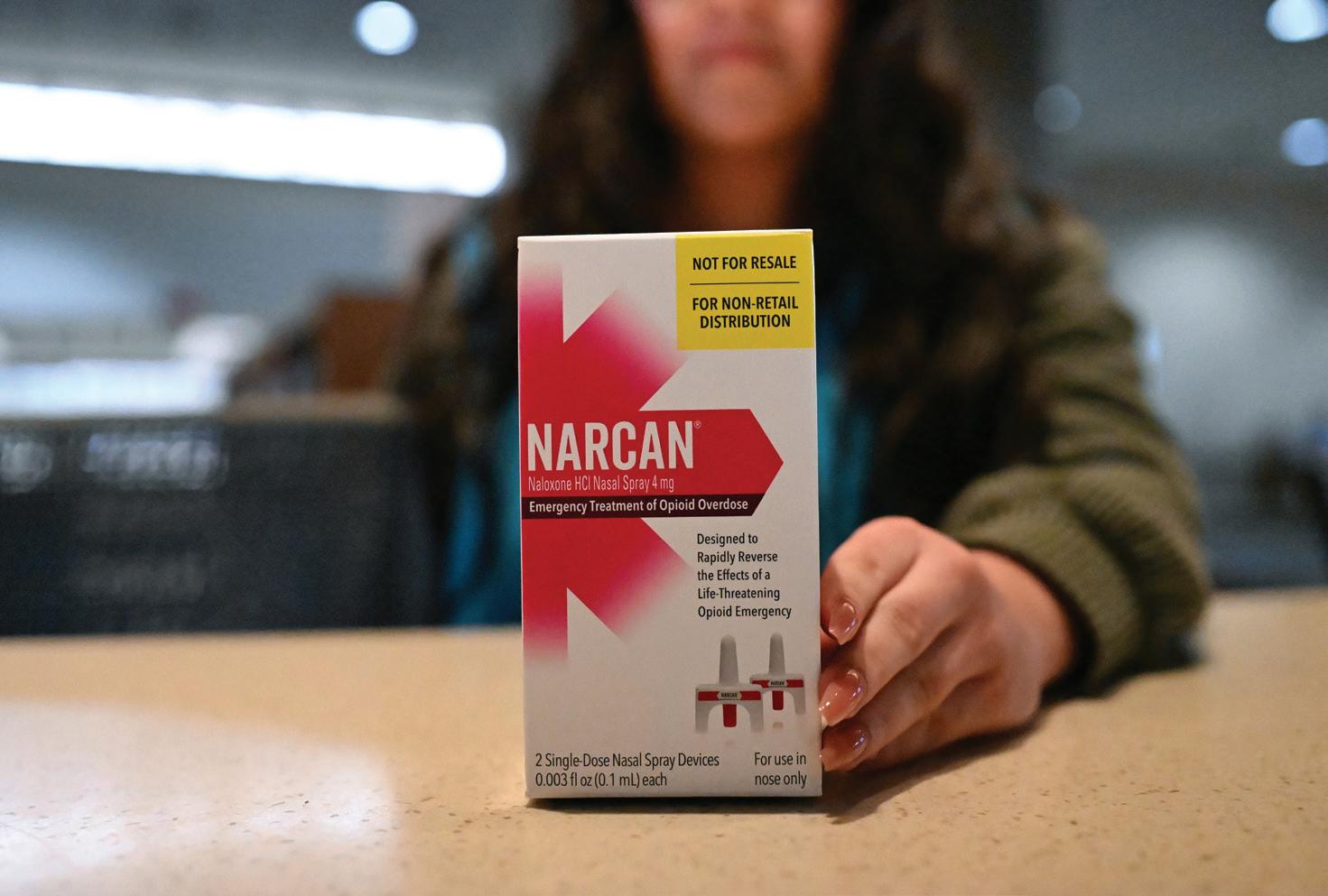
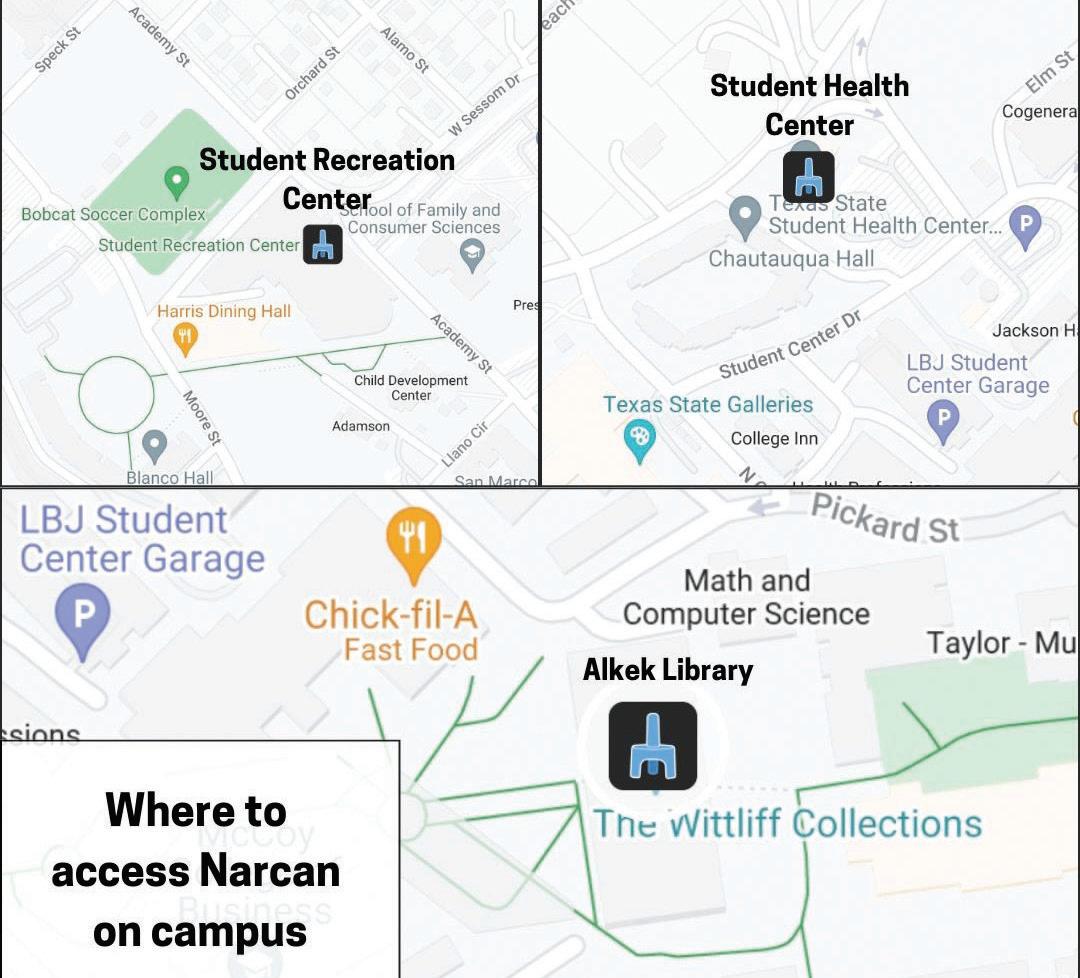
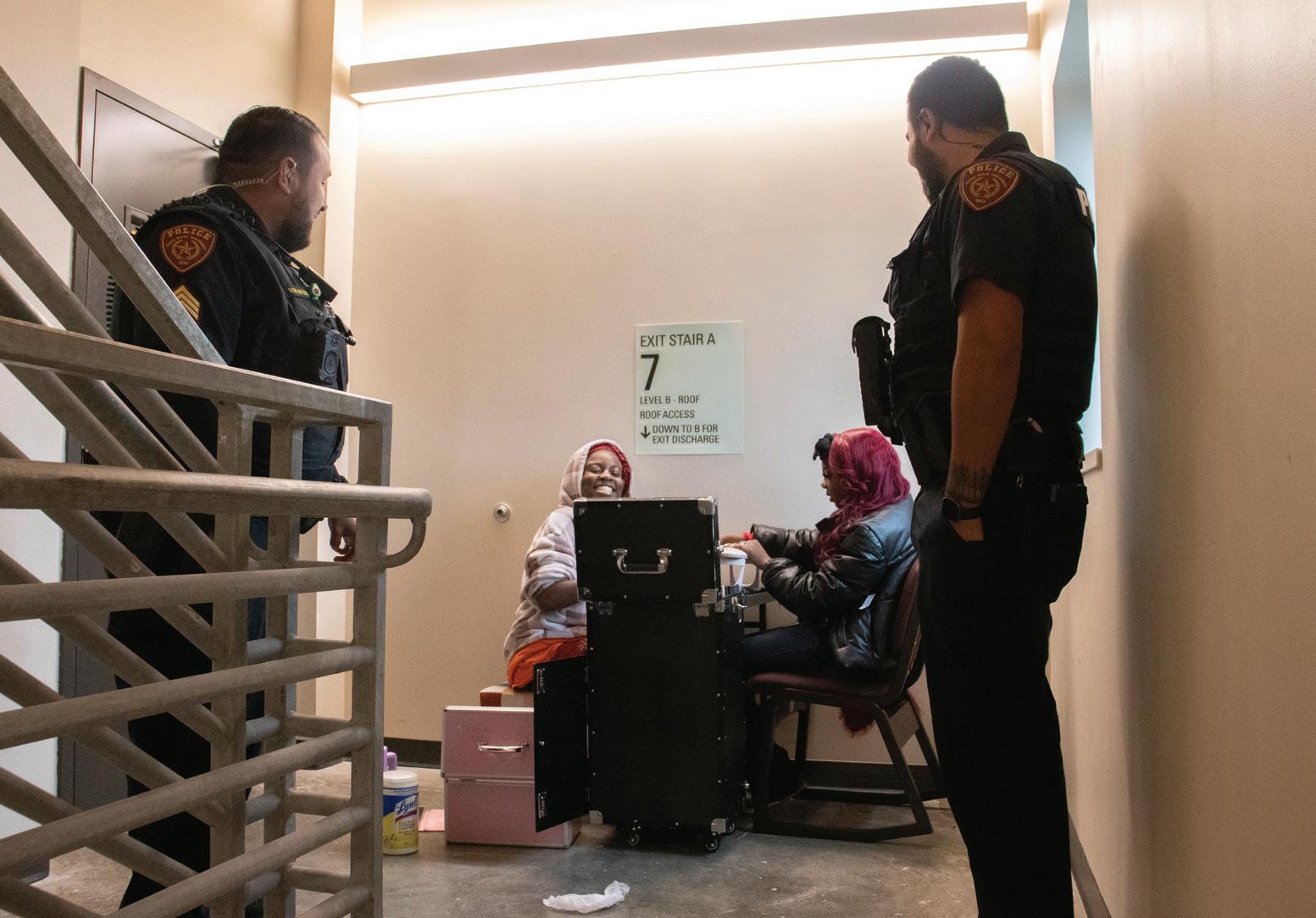
personally felt unsafe in her dorm, she feels safer knowing officers are there, especially following the sexual assault
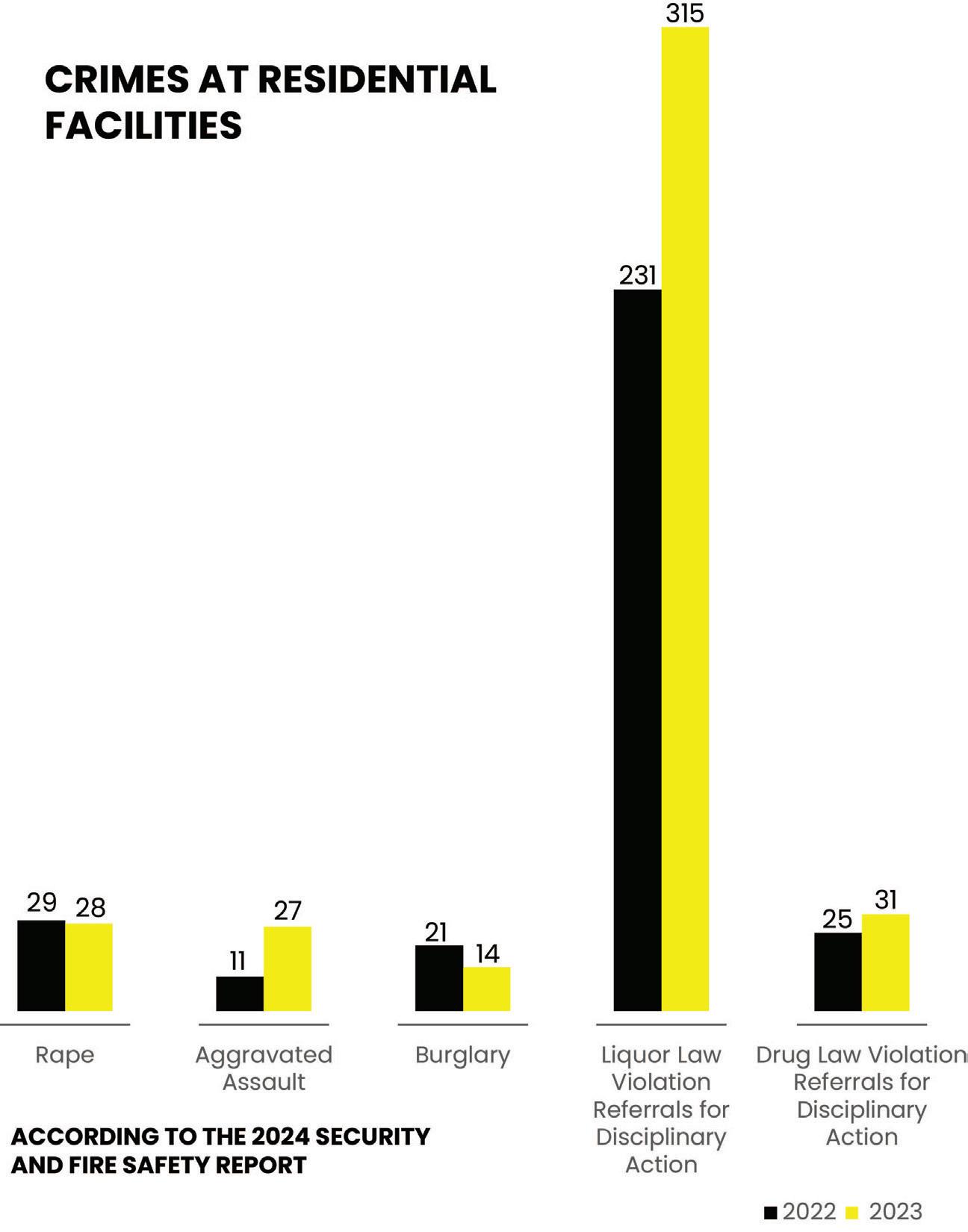
report at Alamito in November 2024.
“If something were to happen, I know that they’re right there, rather than having to call them and wait for someone,” Baeza said.
Carmichael said the increase in patrols is not due to a rise in crime.
According to the 2024 Annual Security and Fire Safety Report, most crimes in residential facilities decreased from 2022 to 2023, with increases in aggravated assault and referrals for disciplinary action related to liquor and drug law violations.
“Addressing drugs and alcohol on campus is one of our responsibilities, but it wasn’t even a thought for these preventive patrols,” Carmichael said.
UPD has a staffing shortage, reflecting a national trend at police departments, according to Carmichael. He said they are reassigning special assignment personnel, including some detectives and lieutenants, to patrol duties to help alleviate the strain of understaffing.
UPD is also hiring student Public Safety Officers (PSO) to address the shortage. There are currently six student PSOs, with one in the training process and another in the onboarding process, who currently focus on parking enforcement, allowing other officers to shift to dorm patrol.
“It’s starting to get on the cusp of getting better and I feel like by fall we should be back up in a good place,” Carmichael said.
Roommates Ash Alday, health sciences freshman, and Tristyn Garcia, biology freshman, said they only saw officers patrol their dorm, Jackson Hall, for the first two weeks of the spring semester.
Garcia said she feels unsafe in her dorm after experiencing two incidents—one involving a stalker and another in which her belongings, including her Social Security card, were stolen.
“If police were to patrol it would be better than nothing,” Garcia said. “I would feel safer because I do go out a lot and coming back so late to the dorm, just having someone here in case something were to happen again.”
Alday said she hasn’t seen the “no ID, no entry” being enforced at Jackson Hall either because the front door is always open.
“I honestly feel like at any given moment if Tristyn’s stalker or someone really wanted to do something to anybody in this building it could easily happen,” Alday said.
Carmichael said they plan to continue increasing patrols going forward as UPD hires more personnel and PSOs.
“This is an access issue, not just access into the building, but this is a response to access for our students to get to police officers,” Carmichael said. “We have to be good about making it so students don’t have to come to the police department every time they need help.”
If officers are not physically patrolling, Carmichael said they are monitoring security cameras on campus and around residential halls.
Students can contact UPD at 512-245-2805 or use Emergency Call Boxes in an emergency.
Tuesday, February 18, 2025
Opinions in The University Star are not necessarily those of our entire publication, Texas State University’s administration, Board of Regents, School of Journalism and Mass Communication or Student Publications Board.
By Staff
For the third Black History Month edition of “Speak On It,”
The University Star interviewed the National Association for the Advancement of Colored People (NAACP) President Jordan Williams to hear his perspective on the experiences of Black students at Texas State.
The NAACP was founded in 1909 to fight for civil rights and justice. Williams said the Texas State NAACP chapter doesn’t cater to only Black students.
“Ultimately our goal is to end racial injustice around the United States and more specifically on the Texas State campus,” Williams said. “We’re mainly focused on working with student government and building student alliances so we can come together and take a stand.”
Williams said during his time as the NAACP president, he has worked through many instances of discrimination at Texas State. One that
stands out to him was when a student’s car was vandalized with a racial slur on Sept. 24, 2024.
“Having to deal with it directly [was] a really bad experience for me,” Williams said. “Having to speak to the victim and [his] family, it made me sad to know that’s what they have to go through.”
Williams said at the time of the incident, university administration wasn’t working to help the victim.
In an Oct. 3, 2024 Instagram post, Williams urged President Kelly Damphousse to speak out against the hate crime.
For Williams, it was disheartening that the NAACP had to push for the university to speak out against discrimination on campus. Damphousse ultimately did respond, but, to Williams, there will always be room for improvement.
“[That incident] was the only time I’ve ever seen Texas State University speak out about something like that,” Williams said. “Student organizations always speak out and that’s one thing
Board. Opinions expressed are not necessarily those of our entire publication.
I love about Texas State. We were able to pressure and move the university through the way we speak.”
Since the implementation of Senate Bill (SB) 17, a bill requiring Texas universities to shut down diversity, equity and inclusion (DEI) offices, at Texas State, Williams said he no longer feels like he has equal opportunities when compared to his white peers.
“As a minority, I have to work 10 times as hard just to get on the same level as someone who doesn’t have the same skin color as me,” Williams said. “We’re fighting for stuff that we fought for 50 years ago. It makes it really hard to progress forward when we keep going back more and more.”
Williams said Texas State has not communicated with the NAACP since DEI offices were dissolved.
“I wish [Texas State] would come out and take a stand on what it is they plan to do
to help minority people on campus,” Williams said. “While I understand they can’t put [DEI] in place directly, I wish they had some sort of team that was able to work with us… to protect those students.”
Despite the hardships, Williams said the NAACP is dedicated to advocating for students. The organization is currently working on a seminar for students dedicated to information about Project 2025, as well as lobbying and writing to Texas legislators.

By Andrew Bencivengo Opinions Contributor
On Jan. 20, 2025, President Donald Trump signed DHS Directive: Enforcement Actions in or Near Protected Areas, overturning previous protections limiting U.S. Immigration and Customs Enforcement (ICE) operations in sensitive locations, including university campuses.
With this decision, areas once considered safe for undocumented students are now open to enforcement actions. Despite the risk this poses to students, Texas State has yet to take sufficient action.
As a Hispanic-Serving Institution (HSI) since 2011, Texas State’s student body is approximately 40% Hispanic, with 42% of undergraduate students being first-generation college attendees, according to Texas State demographics. As a university that promotes diversity and student safety, Texas State must take a stronger stance to protect its students.
The new federal policy disproportionately impacts undocumented and first-generation students, many of whom already face significant obstacles in higher education. Now, students are experiencing heightened anxiety in a space that once felt secure.
On Feb. 7, Texas State reinforced immigration enforcement protocols for faculty and staff, emphasizing legal compliance and student privacy. Faculty and staff were instructed to report ICE inquiries to the university’s general counsel, refer immigration agents to UPD and only share student information if it complies with privacy laws, according to an email sent out by the university. However, these measures do not explicitly restrict ICE access to non-public areas.
While these protocols outline basic guidelines, they do not provide clear guidance on how students should handle direct encounters. Stronger protections are necessary to ensure students’ constitutional rights are upheld.
Other institutions across the state have already taken steps in protecting the rights of their students. Texas A&M issued notices instructing students on where ICE agents are allowed to legally enter and how to respond to immigration enforcement. The University of Houston is barring ICE agents from entering lecture rooms without a judge-signed warrant and offering legal counsel to students questioned by ICE.
Policies such as these ensure the rights of the student body remain while also lessening anxieties from broader immigration enforcement.
Recent ICE raids across the state have intensified fear amongst the general student body, particularly in undocumented students. ICE has conducted operations in nearby cities, including Austin and San Antonio. Without stronger actions from the university, these fears remain present.
In response, Texas State students have taken to protesting, demanding stronger protections for undocumented peers. Students are vocal in calling for non-cooperation policies, expanded legal resources and a firmer stance against ICE enforcement.
Dani Lazo Ojeda, an art history freshman and first-generation student from Venezuela under Temporary Protected Status (TPS), a designation that grants temporary protection from deportation to individuals from countries facing conflict or disaster, said she feels uneasy as a student right now.
“I think enforcement feels very
The University Star welcomes letters from our readers. Letters must be 300 words or fewer to be considered for publication. Writers must include their full name, mailing address, major and academic year designation (for students), phone number and e-mail address when submitting a letter. Submissions that do not include this information cannot be published. This information is seen only by the editors and is used to verify the identify of the

targeted, especially in Texas,” Ojeda said. “I don’t feel safe on campus. I never know what is going to happen or if the university will have my back. I wake up every day scared, questioning every step I take. It all comes down to one piece of plastic [visa] that protects my right to be here, but even that doesn’t feel assured.”
Ojeda emphasized the need for Texas State to step up and take more direct action.
Texas State is failing its undocumented students, exposing them to ICE enforcement and stripping away their sense of safety. For immigrants, this is not another federal order but a threat to their way of life.
Without real action, through restricting ICE access, providing legal aid and addressing student concerns, the university’s commitment to protecting students is just empty promises.
-Andrew Bencivengo is a business administration sophomore
“Give us the power to defend ourselves and our rights,” Ojeda said. “I want more direct action and a clear, official statement. Send an email, hold a workshop—just do something. The biggest issue is that we don’t know what to do or what is going on. Some of us have to seek out these resources when it would be so much easier if they were provided to us.”
letter writer. It is not used for any commercial purpose.
Letters become the property of The Star and may be republished in any format. The letter may be edited for length and clarity. An editor will contact the letter writer if their letter is a candidate for publication. The Star will not run letters that are potentially libelous, discriminatory, obscene, threatening or promotional in nature.
Letters can be submitted to staropinion@txstate.edu or by mail to Attn: Opinion Editor, The University Star, 601 University Drive, San Marcos, TX, 78666.







By Carlene Ottah Life & Arts Editor
The Calaboose African American History Museum hosted the 30th anniversary of the Willie Mae Mitchell Community Opportunity Center on Feb. 15.
As part of its Black History Month celebration, the Calaboose invited Kyev Tatum, pastor of New Mount Rose Missionary Baptist Church, to speak about the Mitchell Center’s history. He started the effort to turn the building into a learning center for the youth in the mid-1990s.
“Whenever you do something, you want it to last long after you’re gone,” Tatum said. “If you stay at it long enough, and you do your best at it long enough, you are guaranteed success.”
History of The Mitchell Center
The Mitchell Center started as an old army barracks Hays County purchased from Camp Swift in 1946. It expanded what was then called the San Marcos Colored School, which was renamed Dunbar School after the poet Paul Lawrence Dunbar in 1961. The school closed in 1964 due to school integration.
In 1971, the property turned into Dunbar Park. A fire in 1986 destroyed the school. The barracks were unharmed and relocated offsite to rebuild the park the following year.
Tatum, then a Texas State University coordinator, discovered the barracks in 1993 during a tour with his Leadership San Marcos class. He wanted to
Cody Taylor, Texas State alumnus, is one of four co-owners taking over Grins beginning Feb. 28.
“Grins is a legacy restaurant, and to have the opportunity to be a part of a legacy restaurant and carry one into the future, is an honor,” Taylor said.
Taylor decided to take on Grins after a few of his friends said his previous experience would make him a good owner. In 2022, he was one of the partners who re-opened Valentino’s Pizza and since 2023 is the sole owner of the restaurant.
Grins has been on the market for almost two years. Sutphen said the reason for the sale is that he is getting older and the owners want to retire.
Sutphen and Ferrell said they had several interested buyers but waited until they found someone they could trust.
“We were picky; I mean, we wanted somebody that knew what they were doing,” Ferrell said. “The main thing was just to keep Grins the same, no change.
help find a building after the teacher for his church’s after-school program died and he saw the teens’ eyes gazing in the air. When Tatum heard about the building’s history, he knew he wanted to return it to the Dunbar community.
“An epiphany happened, “Tatum said. “I said, ‘That is the center for our children.’”
A few community members who graduated from the school believed in Tatum’s vision and encouraged more people. Tatum received money from the city and a grant to move the building to its current location at 715 Valley St. and renovate it.
After six months of renovations, the Mitchell Center opened on Sept. 15, 1995.
“It was unbelievable,” Tatum said. “People from all backgrounds started coming and start investing, and I went to one person who I knew could take it from a rat-infested building and turn it into something beautiful.”
The Mitchell Center expanded by becoming a charter school in 2000 and a Boys & Girls Club the following year. Tatum returned home to Fort Worth in 2004 and left the building to someone else. When the club moved to another building, the Mitchell Center fell out of use until an August 2022 inspection by the city found it to be in disrepair.
Michele Burleson, vice president of the Calaboose, contacted Tatum about the Calaboose’s proposal to obtain the building.
“I had been fighting this cause for the last 15 years with my mother,” Burleson said. “I want this building preserved, and I want it in the community
so locals can be involved in the restaurant’s transition.
“The goal is to keep Grins the same,” Taylor said. “There might be some small changes here and there but it’s definitely going to continue to be Grins.”
Reflecting on their time at Grins, Sutphen said he and Ferrell will have a hard time getting used to not working with young people.

For the past couple of months, Sutphen and Ferrell helped Taylor with his transition and plan to come in as needed over the next several months after they retire.
Although Grins’ management is changing, Taylor wants to continue the restaurant’s legacy by keeping the same style of food and overall restaurant experience. He wants community members to share what they love and what they would want to see changed
“It’s so rewarding, and it keeps us young, keeps us thinking young and physically as young as we can be,” Sutphen said.
“Just that energy we would feed off that.”
Along with their staff Ferrell and Sutphen will miss the customers and regulars who have been going to enjoy Grins for the past 50 years.
“Every time I’m up here, I see people that have been eating here forever, Ferrell said. “Even at H-E-B, I run into people all the time. I may not know their name, but I know their faces from being up here. I’m gonna miss that.”
In the coming years, both Sutphen and Ferrell look forward to coming back to Grins as customers.
“We think we found a great fit for San Marcos and for Grins,” Sutphen said. “We all look forward to coming back and eating. We don’t have to work… just come in and relax.”
and used for something good, so I started to fight that fight.”
The anniversary comes after the San Marcos city council officially transferred the Mitchell Center to the Calaboose on Dec. 18. The Calaboose plans to transfer some of Dunbar’s history to the Mitchell Center, which will take about 18-24 months. Jo Anne Parsons, president of the Calaboose, said the goal is for the Calaboose Museum to tell the story from a jail perspective while the Mitchell Center tells the story of the community.
“[The moving process is] so perfect because you go [to Cephas House], and then you learn about Ulysses Cephas, and then we have the mural right down the street of Ms. Ollie, and then the Mitchell Center,” Parsons said.
When the Calaboose invited Tatum to speak after receiving the proposal, he felt it was important to tell the story of the Mitchell Center so it would not disappear.
“Museums tell stories, right?” Tatum said. “The more stories you have to tell, the more history you have preserved. These kids from San Marcos need to know this little Black kid from Fort Worth didn’t have nothing, came in and did something with people, because people worked with me.”

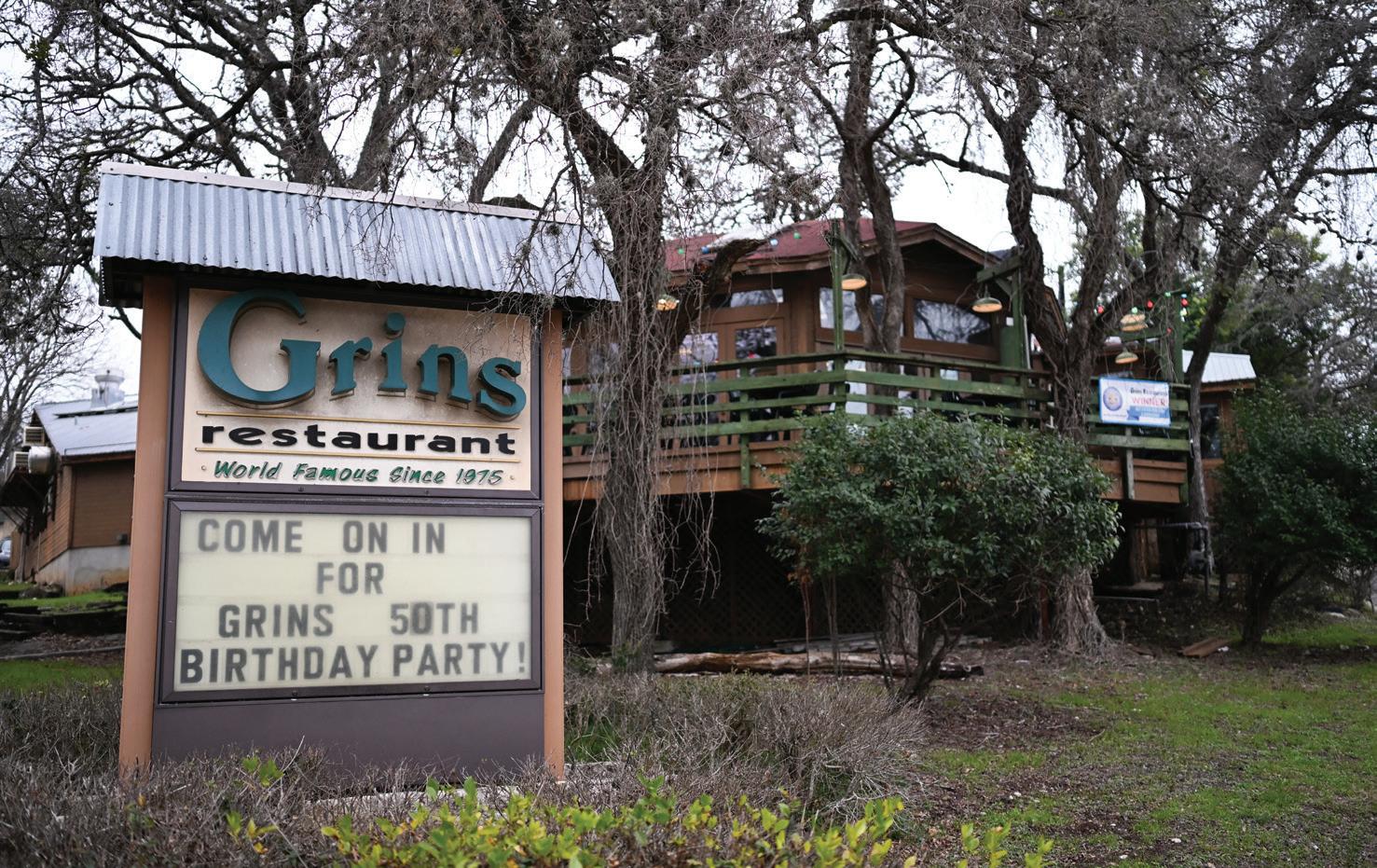
By Jackson Kruse Sports Editor
When you think of Texas State baseball, there’s a good chance you think of shortstop Ryne Farber. To no one’s surprise, the sophomore went 4-for-10 with two doubles in the season-opening series against Binghamton last weekend.
“We all know he’s a stud,” Texas State head coach Steven Trout said. “You always worry, the sophomore year [players tend to] try to do something different, but he’s such a consistent person that, to me, he’s going to have consistent results [on the field] as well. His work ethic hasn’t changed, his personality hasn’t changed and right now, his swing hasn’t changed. I’m really proud of him.”
Farber, a San Antonio native, established himself as a force to be reckoned with last season, slashing .340/.466/.468 in 40 games as a center fielder and designated hitter. Despite the position being unfamiliar, Farber kept a perfect 1.000 fielding percentage while playing center field. His natural position of shortstop was blocked by now-graduate Davis Powell, but Trout knew his bat was too good to keep out of the lineup.
Even with his success last season, Farber missed a significant amount of time due to a lower body injury, hindering Texas State’s chances of making the Sun Belt Conference Tournament. However, that injury is the last topic on Farber’s mind as he begins his sophomore season.
“He’s a really tough kid,” Trout said. “He played the majority of the season last year really hurt [and] he grinded that out. He laid it on the line for the Bobcats.”
Now, in his second collegiate season, Farber is back at the position he played throughout high school. The sophomore star was named to D1Base-
ball’s preseason list of top 50 division one shortstops at No. 20 despite zero collegiate innings at the position until Feb. 14, 2025. Even with his success last season, Farber thinks he can improve in 2025.
“I’ve done a lot to get better and I think I’m a better player than I was last year,” Farber said.
Farber’s freshman season, minus the injury, nearly mirrored fellow Bobcat infielder Chase Mora’s 2023 freshman season, where he hit .316/.382/.653. Now, the two former freshmen standouts share the same infield in leadership roles.
“[Farber and I] are always communicating. I guess last year I kind of felt like it was all me, like I was the only voice [in the infield],” Mora said. “Having a guy like him come into the infield, now you have two guys bringing the energy whether the pitcher is struggling or a guy in the outfield needs to be picked up.”
When Farber is at the plate, whether it be from the right-handed batters box or the left, it seems like he almost always finds a way on base. If he continues to swing the bat like he has, the revamped Texas State team should have a good shot at winning the Sun Belt and appearing in the NCAA Tournament.
Height: 5-11
Class: Sophomore
Hometown: San Antonio
High School: Johnson HS Career Accolades:
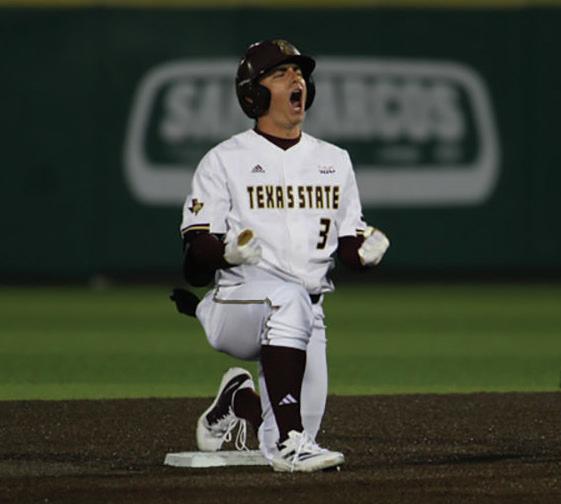
- .344/.468/.477 slashline in 151 at-bats
- 2024 Astros Foundation College Classic All-Tournament Team
- 2024 Karbach Round Rock Classic All-Tournament Classic Team
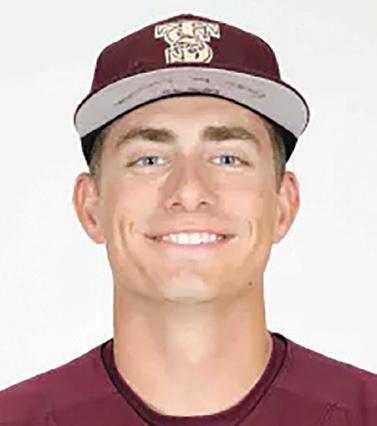
By Jackson Kruse Sports Editor
Ryne Farber and the Texas State Bobcats (3-0) will take on Nolan Schubart and the No. 17 Oklahoma State Cowboys (1-2) at 6:30 p.m. on Tuesday. The game will be at Globe Life Field, home of the Texas Rangers, in Arlington.
“We respect everybody, but we fear nobody,” Texas State head coach Steven Trout said. “We’ve had big wins in this program, and our goal
obviously is to beat those [top-ranked] teams every year.”
Texas State last played at a Major League stadium in the 2024 Astros Foundation Classic, where it went 2-1, winning against Texas and Houston at Minute Maid Park in Houston.
“I know that we will all be really excited and looking forward to getting up [to Arlington] and playing at a big league stadium,” Farber said.
The Bobcats started the 2025

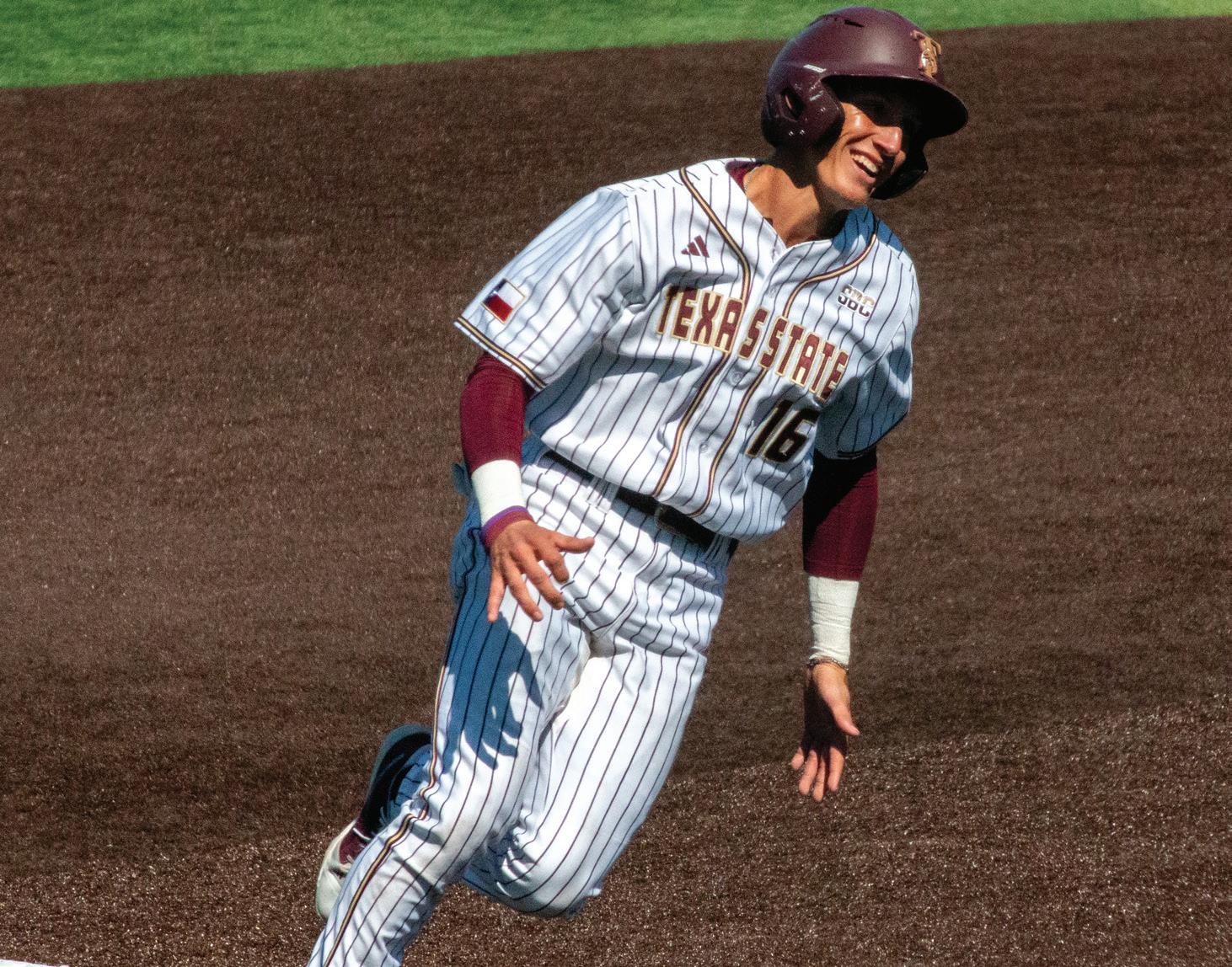
season with a 3-0 sweep over the Binghamton Bearcats last weekend. Their offense went 28-for-95 at the plate, and their pitching staff allowed 10 earned runs in 27 innings. Farber hit .400 with two doubles, Ethan Farris went 5-for-12 with a triple and Zachary Gingrich collected four hits and two walks in 11 at-bats.
Oklahoma State is already in Arlington and competed in the Shriners Children’s College Showdown last weekend, beating Louisville and losing to No. 15 Clemson and No. 19 Texas. Schubart, ranked 20th on D1Baseball’s Top 50 college baseball prospects for the 2025 MLB Draft, went 4-for-10 with three walks in the tournament. Jayson Jones had five hits, including a home run, and Avery Ortiz smashed two home runs.
After Texas State’s win against the Bearcats on Sunday, Trout said he hasn’t decided who will start on the mound on Tuesday. It’s safe to assume it won’t be Jackson Teer, Sam Hall or Austin Eaton, as all three started in the series against Binghamton. However, there is a good chance Texas State fans will see Eaton in the batter’s box, as the redshirt senior assumed
the designated hitter role in games one and two against the Bearcats despite having zero at-bats last season. Trout may go with a bullpen game on Tuesday, but if not, he has an array of pitchers who started at either the JUCO or high school level last season. Oklahoma State’s starting pitcher is unknown, but Hunter Watkins, Gabe Davis and Harrison Bodendorf all pitched in the Shriners Children’s College Showdown, which all but eliminated their chances of facing the Bobcats on Tuesday.
While the matchup between Texas State and Oklahoma State will be a non-conference game, a win for the Bobcats against a ranked team could boost their confidence and prove vital come NCAA tournament selection day.
“I think it’s going to be awesome,” Farris said. “We’re geared up for it, we’re ready for it, but we’re also going to treat it just like another baseball game.”
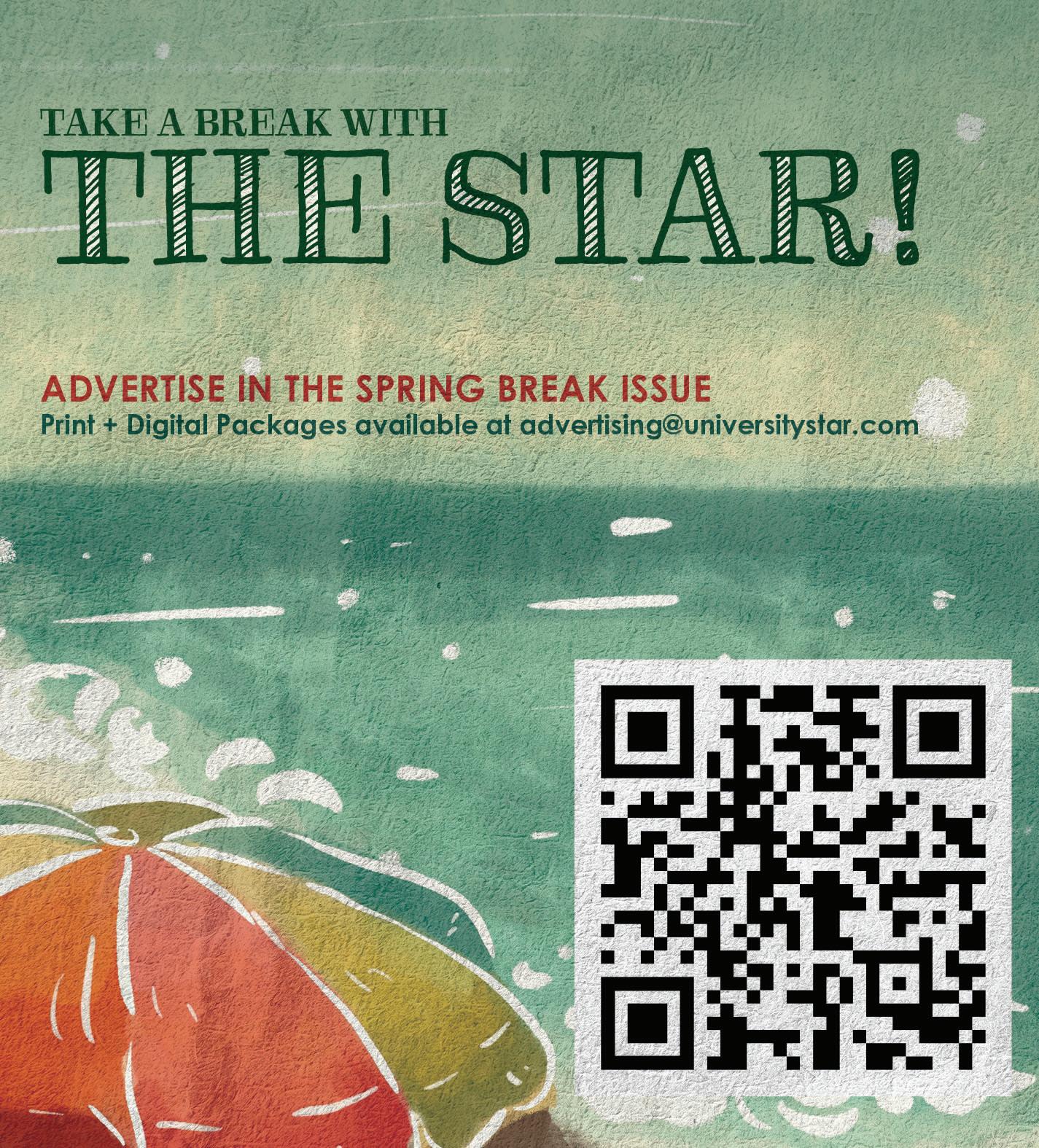
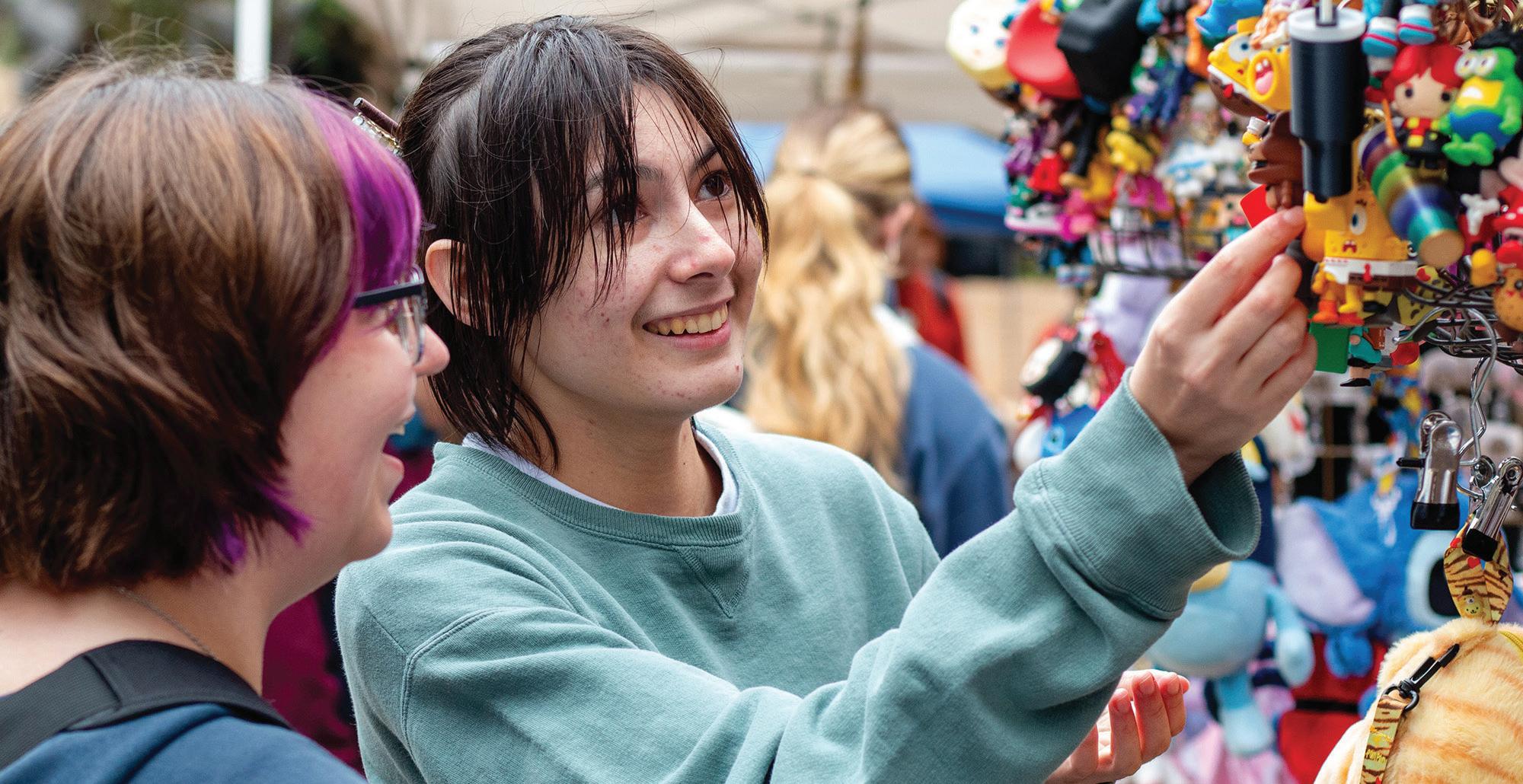
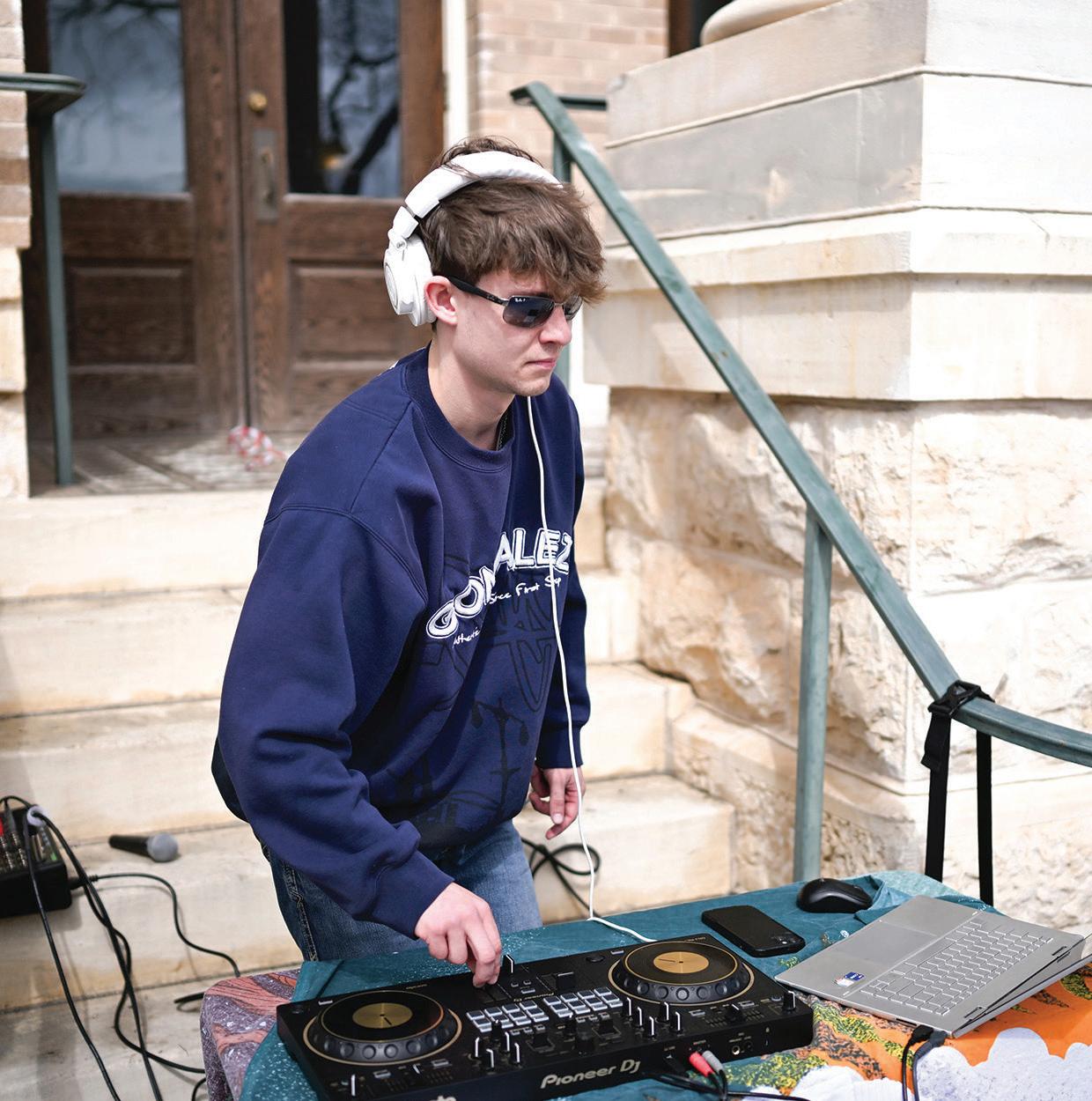


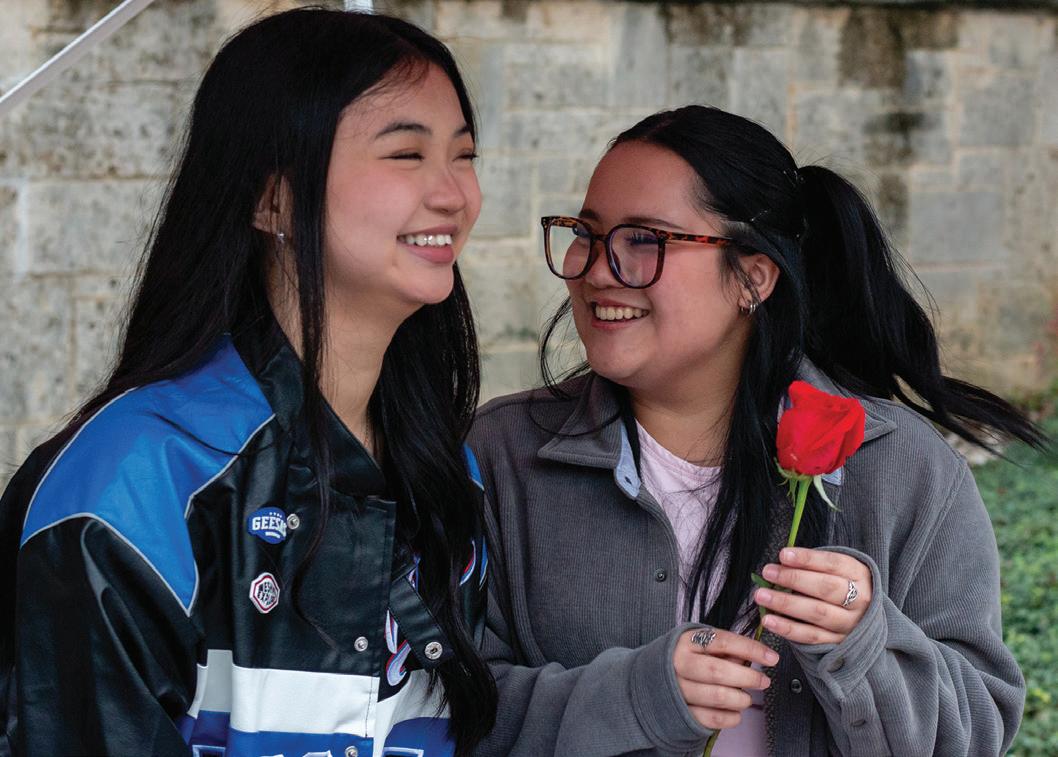
Texas State health sciences
sophomore Quinn Brasher (Right) and biochemistry sophomore Alissa Short (Left) browse keychains and trinkets sold at Market Day, Wednesday, Feb. 12, 2025, on the Quad. The variety of vendors’ goods included food, jewelry, crocheted goods, knick knacks and more.
Wednesday,
freshman Jasmine
and
engineering freshman Ava Phan
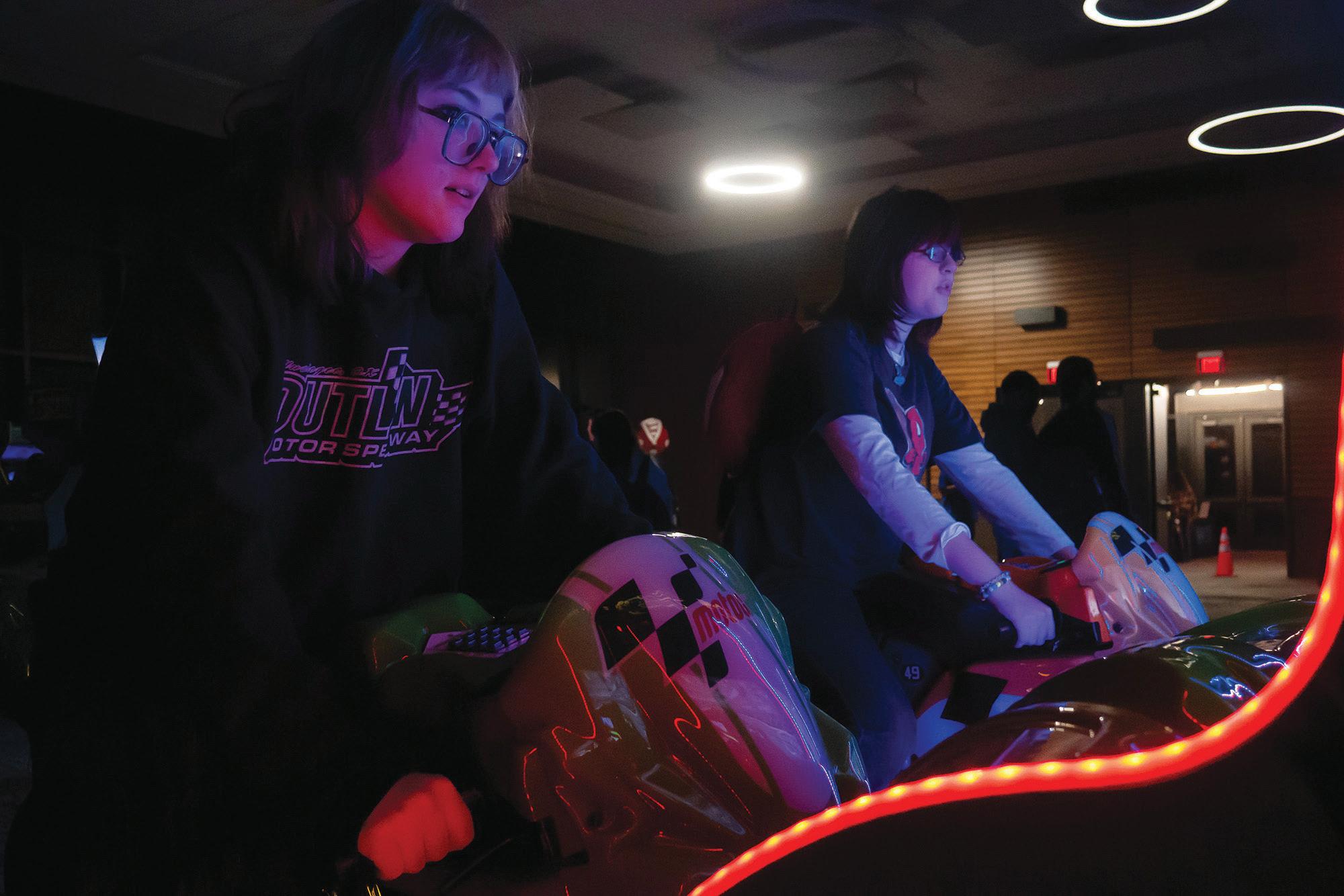
Scan the QR code to view the
